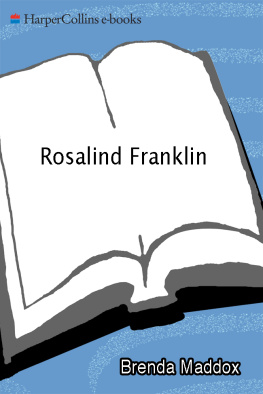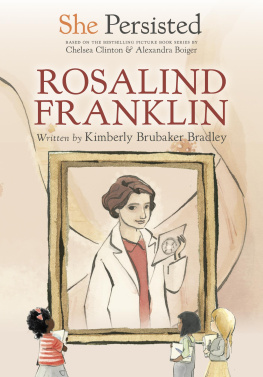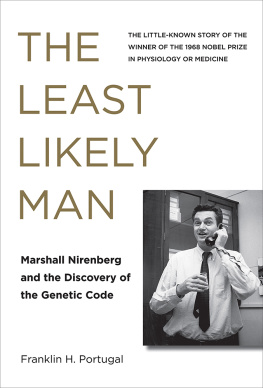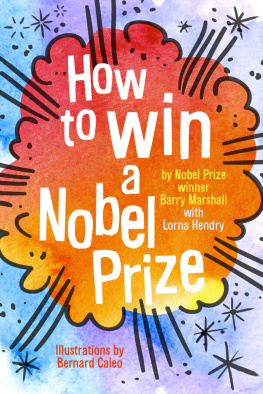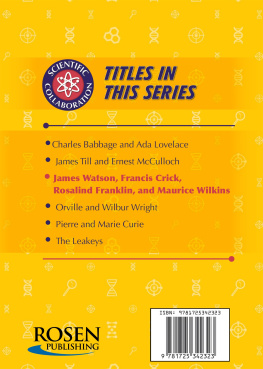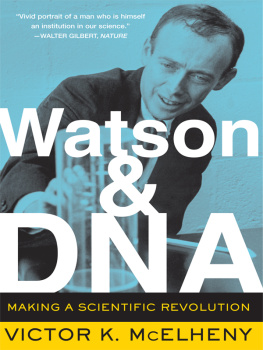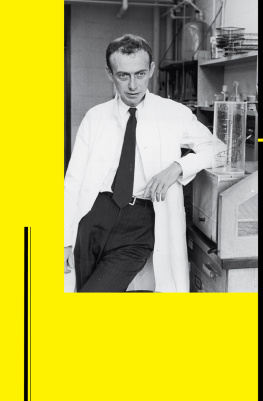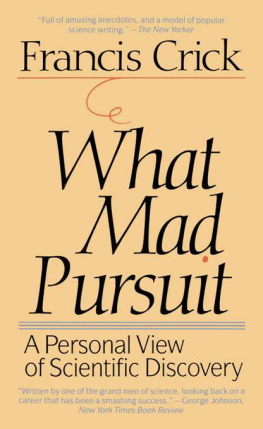For John
CONTENTS
Rosalinds great-grandparents. (Records of the Franklin Family)
Rosalinds grandparents. (From Portrait of Ellis by Muriel Franklin)
Rosalinds great-uncle, Sir (late Viscount) Herbert Samuel. ( Bettmann/Corbis)
Three sons and a daughter. (From Portrait of Ellis by Muriel Franklin)
A smile to come home to: Nannie Ada Griffiths (From Portrait of Ellis by Muriel Franklin)
Norland Place School Golden Jubilee. (Norland Place School)
Rosalind and her new sister, Jenifer. (Jenifer Glynn)
Rosalind as a hockey-playing Paulina. (Valerie Sutton-Mattocks)
Rosalind in Norway with her precious climbing boots. ( Jenifer Glynn)
Ellis A. Franklin. (From Portrait of Ellis by Muriel Franklin)
Working scientist: Rosalind with colleagues at the BCURA. (Xavier Duval)
Five shots of Rosalind on the mountain holidays she loved. (All from Margaret Nance Pierce except close-up of head, turbaned, and shoulders by Vittorio Luzzati)
Rosalind with friends in Brittany. (Margaret Nance Pierce)
Bare-legged Rosalind with colleagues in Lyons. (Rachel Glaeser)
Philip H. Emmett, Rosalind and Marcel Matthieu. (Rachel Glaeser)
At the same conference in Lyons: Haisinski, Jacques Mering, Rosalind and Irene Perrin. (Rachel Glaeser)
Outside lEcole de Physique et Chimie in Paris. (Alice Oberlin)
Adrienne Weill enjoying a joke with Mering. (Philip Hemily)
Vittorio Luzzatis snapshot of Rosalind in the Cabane des Evettes. (Vittorio Luzzati/National Portrait Gallery)
The after-lunch coffee-making ritual at the labo. (Rachel Glaeser)
Rosalind, following Luzzati, at Uppsala. (American Society for Microbiology Archives, Anne Sayre Collection of Rosalind Franklin Materials)
Professor J.T. Randall. (S. Chomet)
Interdepartmental cricket match, Kings College London. (Dr Bruce Fraser)
James Watson at Cold Spring Harbor, Long Island. (Courtesy of the Cold Spring Harbor Laboratory Archives)
Maurice Wilkins. (S. Chomet)
Rosalinds lab at Birkbeck. (Dr John Finch)
Rosalinds young team at Birkbeck. (Dr John Finch)
Professor J.D. Sage Bernal. (Wolfgang Suschitzky/National Portrait Gallery)
Isidore Fankuchen, Dorothy Hodgkin, J.D. Bernal, and Dina Fankuchen. (Courtesy of the Bodleian Library, Oxford, Ms.Eng.c.5715, Folder J.7)
Madrid, 2 April 1956, at an International Union of Crystallography Symposium. (Dr D.L.D. Caspar)
Rosalinds last look at the Matterhorn with Don Caspar and Richard Franklin. (Dr D.L.D. Caspar)
Muriel and Ellis Franklin on their ruby wedding anniversary. (From Portrait of Ellis by Muriel Franklin)
Watson, Crick and their DNA model in 1953. (A. Barrington Brown/Science Photo Library)
To the victors: the Nobel prize line-up in Stockholm in 1962. ( Bettmann/Corbis)
Too deep for tears: Rosalind in a pensive mood. (Elliott & Fry/ National Portrait Gallery)
ILLUSTRATIONS IN TEXT
The pagination of this electronic edition does not match the edition from which it was created. To locate a specific entry, please use your e-book readers search tools.
| p. 57 | Rosalinds undergraduate notebook headed Crystal Physics. (Churchill Archives Centre, Franklin Papers FRKN 3/23) |
| p. 89 | Graphitising and non-graphitising carbons. (From Crystallite growth in graphitising and non-graphitising carbons by Rosalind E. Franklin, Proceedings of the Royal Society, 1951, A209, p 212) |
| p. 154 | DNA A and B forms. (Reprinted from C.J. Alden and S.H. Kim, Journal of Molecular Biology 132, pp. 41134, 1979 by permission of the publisher Academic Press/ Elsevier Science) |
| p. 197 | Rosalinds Photograph 51 of the B form of DNA. (Jeremy Norman) |
| p. 203 | How the double helix copies itself. (Reprinted with the permission of Scribner, a Division of Simon & Schuster, and of Weidenfeld & Nicolson from The Double Helix by James D. Watson. Copyright 1968 Elizabeth L. Watson, as Trustee under Agreement with James D. Watson dated 2 November, 1971; copyright renewed 1996 James D. Watson) |
| p. 230 | What TMV (tobacco mosaic virus) does to tobacco leaves. (L. Bos, Plant Research International, WUR, Wageningen, the Netherlands) |
| p. 259 | Summary of the first analysis of the structure of TMV. (From a review by A. Klug and D.L.D. Caspar entitled Structure of Small Viruses published in Advances in Virus Research, Academic Press, 1960) |
Rosalind Franklin apart, the principals in the drama of the discovery of the structure of DNA in 1953 survived into the twenty- first century. I have been fortunate to have had many discussions with Dr Francis Crick, Dr James Watson, and Professor Maurice Wilkins. All three have been generous with their time, their recollections, opinions and permissions to quote unpublished letters. Among Rosalinds close associates, those who have shown great interest and offers of assistance include Professor D.L.D. Caspar, Dr K.C. Holmes, Professor Raymond Gosling, Sir Aaron Klug and Dr Vittorio Luzzati.
As I went along, I was surprised (and relieved) by the willingness of scientists to discuss their work with someone with a rudimentary scientific vocabulary. Their patience is explained, I think, by the inherent openness of science as well as by a sincere wish to help set a tangled record straight: Dr John Finch, Professor Bruce Fraser, Dr Durward W.J. Cruickshank, Dr William Ginoza, Professor Alan Mackay, Dr Peter Pauling, Dr Margaret Nance Pierce and Professor H.R. Wilson are among those who sent material from their personal archives, as did the historian who did the research for the BBCs 1987 film, Life Story, Jane Callander, Dr June Goodfield and Horace Freeland Judson. That so many volunteered to help is owing to the kindness of the editor of Nature, Dr Philip Campbell, who published my letter announcing the planned biography. The scope of the response was a small reminder of Natures global reach and influence.
A great privilege accorded me was access to Rosalinds vivid personal letters, written from her childhood until her last weeks of life. I am deeply grateful to Jenifer Franklin Glynn, and also to Colin and Roland Franklin, for allowing liberal quotation from these without asking to authorise or even agree with the resulting book. These quotations allow Rosalind to speak in her own voice at last, and the real person to emerge from the accretion of myth and caricature.
I am also indebted to those who read the manuscript in rough form, Professor Paul Doty, Dr Walter Gratzer, Dr K.C. Holmes, Professor Ian Glynn, Sir John Maddox and Bernard McGinley. I am grateful, as in previous biographies, for the expert eye on photographs of the historian of twentieth-century fashion, Jane Mulvagh. Any errors remaining are unquestionably my own.
Dr Gunther Stents masterly critical edition of The Double Helix was invaluable, with its inclusion of the three DNA papers which appeared in Nature on 25 April 1953, as well as the original reviews of Watsons book and subsequent articles stimulated by the controversy that followed publication.
This biography could not have been written without the resources of many libraries and archives. The principal collections of Rosalind Franklin papers outside the family holdings are in the Anne Sayre Archive held by the American Society for Microbiology Archives at the University of Maryland, Baltimore County, under the supervision of Jeff Karr, archivist; in the Franklin papers at Churchill College Library, Cambridge, which also holds the J.T. Randall papers, and in Jeremy Normans Archive of Molecular Biology at Novato, California, whose holdings include the papers of Aaron Klug, Max Perutz and some of Rosalind herself.

